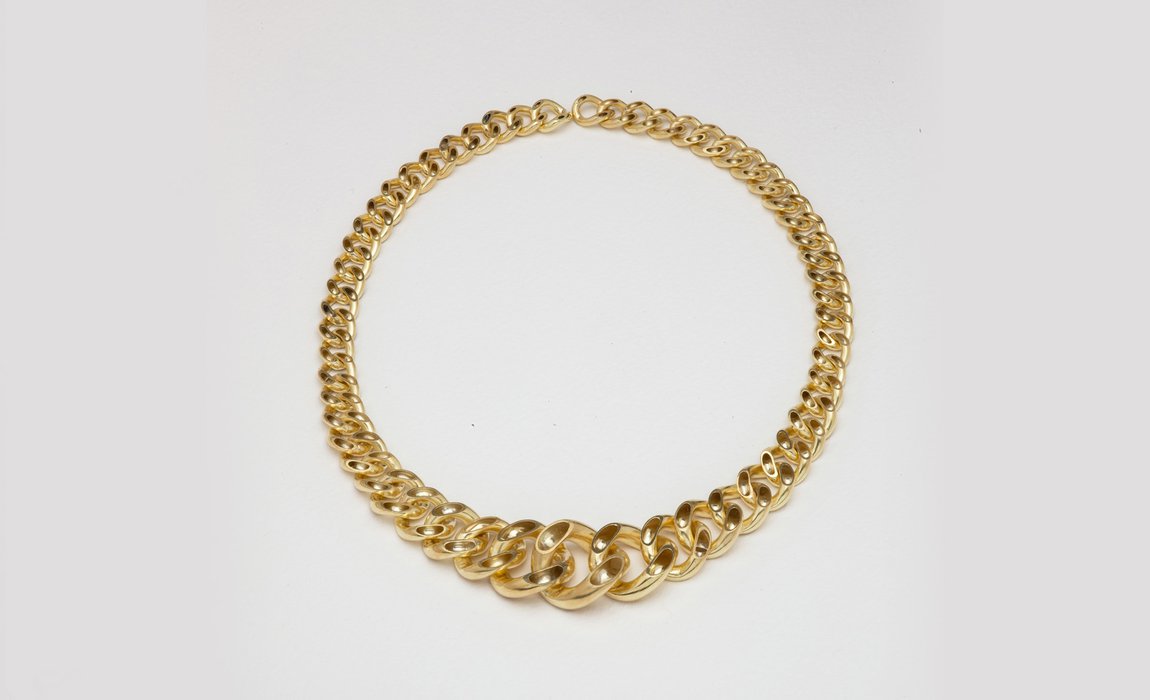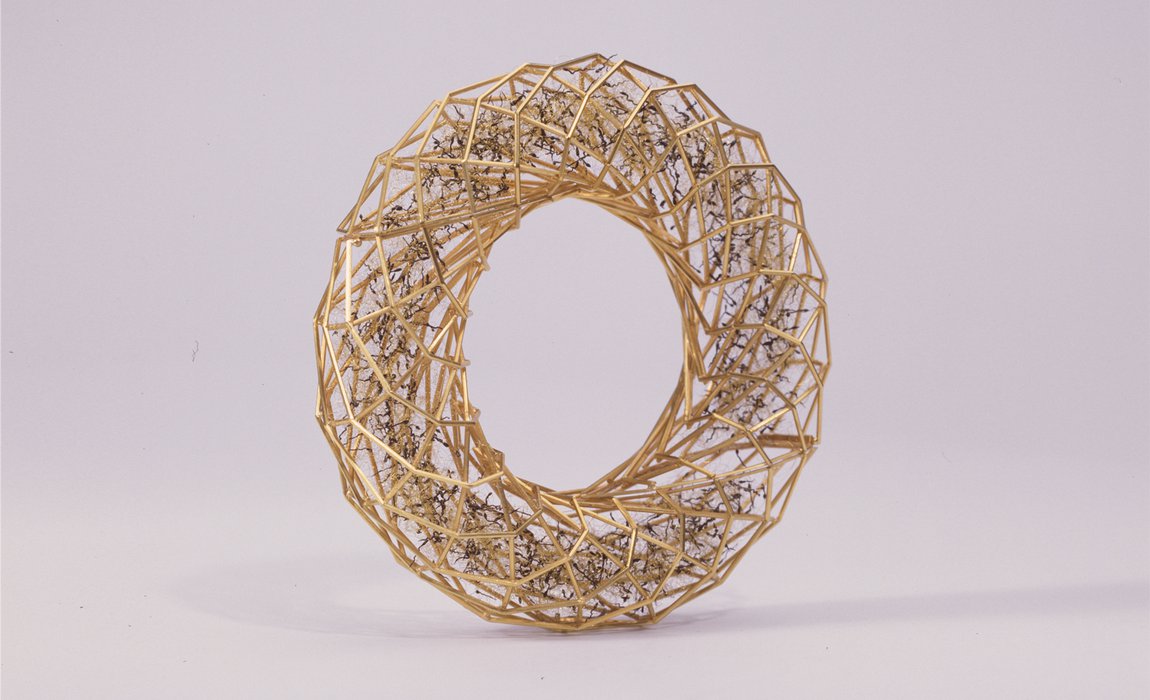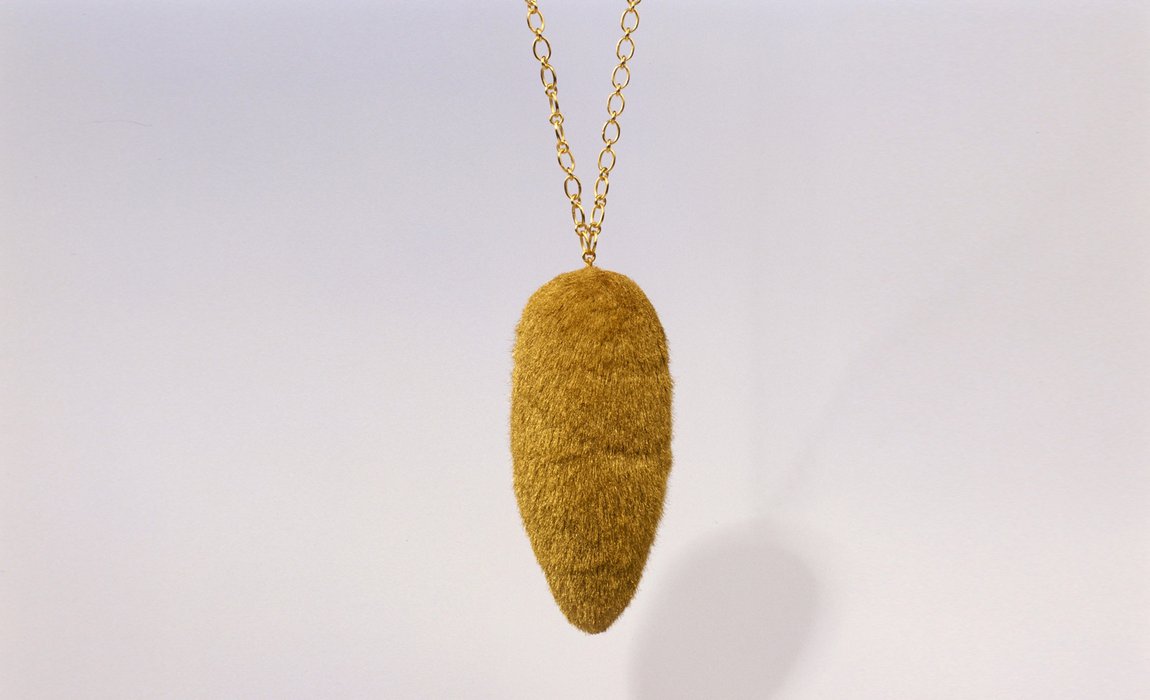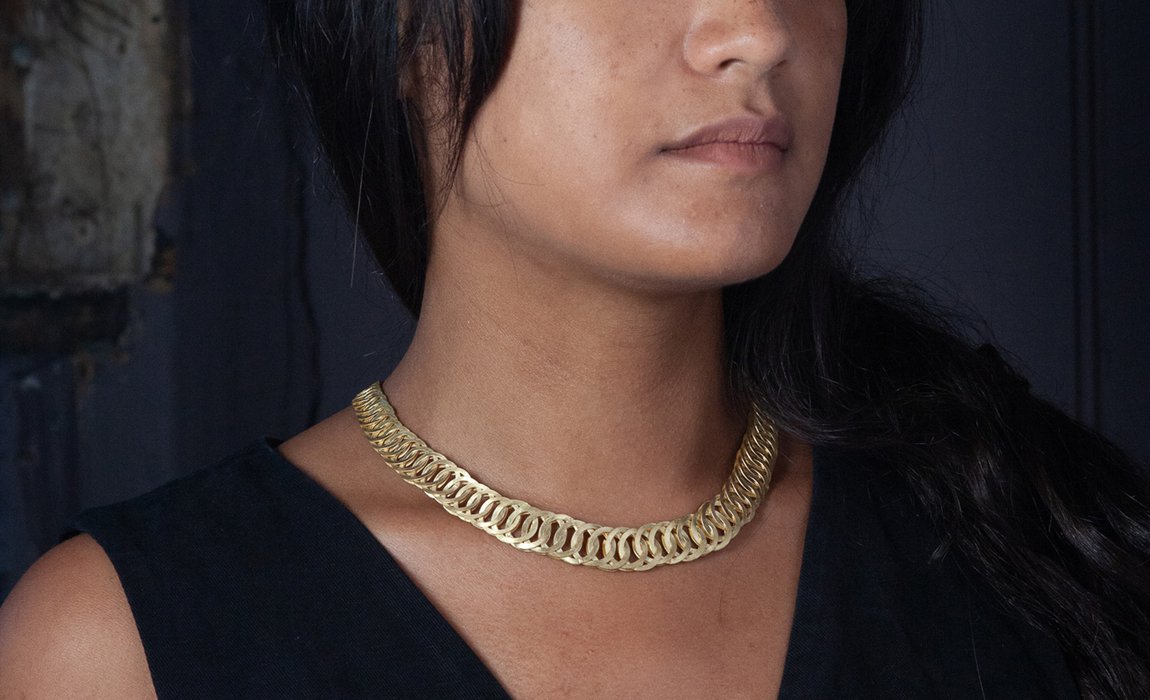The magic of transforming wire: Lucie Gledhill and Giovanni Corvaja
Jeweller Lucie Gledhill is one of four pioneering craftspeople to have received a Career Catalyst Grant from the Goldsmiths’ Centre in 2020, worth £5,000. With the help of the grant, which is supported by the Goldsmiths’ Company Charity and the Radcliffe Trust, she is receiving virtual mentoring from world renowned Italian goldsmith artist Giovanni Corvaja and is in the process of innovating traditional wirework techniques for jewellery.
Giovanni Corvaja is known as the technical master of gold wirework, creating works of art out of wire as fine as human hair. In this interview, Lucie speaks to her mentor Giovanni about his early fascination with drawn wire, their shared passion for science and craftsmanship, and the importance of passing on your knowledge to others.
Lucie Gledhill and Giovanni Corvaja in conversation
Lucie: How did your interest in gold and silver begin?
Giovanni: My obsession with metals in general began when I was a child. I collected pieces of metal from the ground such as empty shells from the First World War and lead weights from fishermen found on the beach. The abandoned nets of the fishermen are of course extremely polluting, not only because of the plastic, but also because they contain kilos and kilos of lead, and as a child I would play with them and I also melted little soldiers for my brother.
At 13 I started art school, a gymnasium in Padua, the European equivalent of an advanced secondary school, where they offered a lot of art in the programme. I choose my direction and specialised in metalwork and jewellery. I went there because my dream was to melt silver, and I didn’t think about gold of course because of the price, but silver we had in the house in the form of objects like cutlery.
Lucie: So, you wanted to see silver change state?
Giovanni: Yes, the ability of manipulating and creating something small with precious metals, which doesn’t change through time; that was a mystery for me, and a process I wanted to learn. I was drawn to that – the art of transformation.
Lucie: That’s interesting for a number of reasons – when I researched Albertus Magnus, he also studied at Padua in 1223. Is it a very famous university?
Giovanni: Padua is one of the oldest universities in Europe and the second oldest university in Italy, dating back to the 13th century. Lots of famous scientists, like Galileo, started their careers there.
The university is a big part of the economy and the structure of the town. It is also the reason why I was born there as my father was a university professor in chemistry in Padua and my mother was also a professor of chemistry. They met at the university.
Lucie: It’s like you are born of the university!
Giovanni: Yes, because otherwise my parents wouldn’t have met. My father is from Venice and my mother is from the mountains in the north east of Italy. Somehow all our connections are through the university of Padua. At the moment two of my brothers are professors in Padua and one in Udine; so this is a normal profession for my family.


Lucie: So, chemistry was very much part of your childhood and upbringing?
Giovanni: My parents would not force chemistry on us, but they would explain it in a simple way. This happens because of this reason. For example, if you put sugar in water, you cool it down – not because the sugar is cold but because you gain energy. There are simple, everyday life experiences that were explained to us.
My mother was teaching those who would become chemical technicians, whilst my father was doing research on how molecules behave with particular magnetic fields. The chemistry of my father was less accessible – you would need to be very specialised to understand it.
Lucie: I am also interested in this idea of transformation. Initially when I started working on the SWAP project with artist photographer Kasia Wozniak, it was amazing to see 100 grams of silver dissolved in nitric acid as a transparent liquid, something I had not experienced before. I had seen sugar dissolve in tea, but I had never seen silver dissolve – it was just amazing.
Giovanni: Yes… and changing colour and making smoke!
Lucie: … and then that moment when it crystalised as well and it becomes light sensitive. I couldn’t believe it. It was like magic!
Giovanni: You think it is like magic because magic is like that. There is a perfectly understandable and normal explanation for what is going on at an atomic level. But magic is always an act of transformation.
There are actually two types of magic: one is the magic of the spell. You point your finger, or a wand, and you spell out a magic formula and something happens! And then second is the witchcraft. The word witchcraft is an important word in that it is the making of the craft, where you have to take an action in order to obtain a transformation.
We grow up with the magic of the spell because this is what all children do – they point a finger at a toy, and they get it! A reward corresponds to every action. Then there is the alchemy, the transformation of the label – we have to transform, apply our force and modify things in order to get this transformation. Art is one of many transformations. Building a road, may not be considered art, but it is a transformation.

Lucie: How did your journey working with wire begin?
Giovanni: My journey with gold and silver wire started from quite early on, first out of curiosity. I was still at school and I was learning how to draw down wires, like everybody learns - filing the point and pulling it through a draw plate. I got curious and asked my professor, Francesco Pavan: “How thin can the wire get?” The answer was: “It depends on the draw plate that you have. If you have a very good one, you can go down to 0.1mm or 0.15mm that was his guess.” So, I immediately tried to get this good quality draw plate and make it small. I then realised there was no reason why it couldn’t be thinner and thinner. So, I started working with wire due to technical curiosity to see what happens.
The other reason is that I have an art foundation, 5 years of art school and then at the Royal College of Art and there we did a lot of drawing. I was more of a line person, more of a drawer than a painter. I didn’t like using paint brushes, as I am not a surface person, but more of a line person. And wire is like a line, it can be thicker or thinner – a three-dimensional line. So, what I had in my mind could be expressed better with wire.
Lucie: What I love about wire is that it’s got this liveliness, which translates from the alloy and I prefer it to sheet metal. It is interesting that during my Career Catalyst Grant project, which we are working on at the moment, I am so desperate to handle what I am doing, but you have to be so patient.
Giovanni: It’s a process that you are doing for the first time. You will get a few problems and unpredictable steps, which is all part of the learning curve.
I am very interested to see what will come out of this process. One key aspect of the whole process is that it’s very gentle and elegant. You are not cutting or burning or filing the end of the wire. In fact, we include a different metal to file, so everything is being displaced and not forced together. There is a certain continuity in the process. You start with an ingot and I imagine the two atoms of the same ingot stay attached electrically. There is still a connection between the atoms although they might be 30m, 40m or even km apart. There is also very little wastage in this process, which makes it more sustainable.
Lucie: That is really true! I am trying to account for every milligram.
Giovanni: Whatever you file, you can collect it. Whether you use copper or silver, you will end up with the silver nitrate and the gold will stay at the bottom. Depending on what stays on your hand, you should have almost zero waste.

Lucie: I wanted to just talk about what Albertus Magnus says about metals. He is talking about the relationship between silver and gold, so I was going to read you what he has written and hopefully you can shed some light on it for me. (He is talking about the fabrication of sheet.)
He says: “Gold can be drawn out to the greatest extent so that thin sheets are made which are spun with silk or placed on pictures, and it can be drawn out even further if silver is placed on the gold in the proportion of six to one … then the gold is drawn out as much as the whole of the silver can be, so that the gold is no longer seen except as a colour on the silver. But if the thin sheets are melted the metal does not appear to be gold at all, but entirely silver. But if the gold is beaten by itself, without being placed on silver, it cannot be drawn out so much because it cannot bare the blows of the hammers without being perforated. So, the silver protects it from the blows.
Giovanni: Yes, at that time until quite recently, they didn’t have the technology to make a draw plate accurate enough. You need to go step by step to have the hole highly polished and the metal has to be very, very hard.
They didn’t have the possibility to make a continuous wire. Their way around this was to beat it with a hammer, make a very thin sheet, then cut very thin strips. This bimetal, a technique which is still used in the textile industry and in India for saris, where you see a lot of gold on the clothes. That is not solid gold, its silver with one sixth percentage of gold. Usually it is a very thin strip wrapped around some silk or cotton. If you look at it under the microscope you would see it’s a little, very thin coil.
Obviously yes, if you melt everything together you get an alloy that is white, because it is mainly silver.
Lucie: So one metal is supporting another, this is what interests me. It is also similar to what I am doing with wire, using silver around the gold to support it when drawing it into wire.
Where do you think the boundary between science and craftsmanship lies?
Giovanni: I don’t think there are boundaries as it is all the same field. There is never a point where one starts, and one ends. We take most of the science we use for granted and some of it we don’t understand, but we still use it.
When you put borax on your silver, when you are melting it, you are doing a chemical reaction which helps the fluidity of the metal because it removes oxides and you transform oxides into other substances. So, for me, it’s not a boundary, it is how much you think about it. Probably because of my professors and my parents, I am inclined to want to understand why something happens in order to be able predict it and replicate it, if I want.
I want to have the technique in my hand, not for any kind of virtuosity, I don’t care to say look this is the thinnest wire that has ever been made. It’s important that I made it because I am curious to see how it looks like and how it behaves.
Lucie: I think that there is something about the craftsmanship where for some people it can be about repetition. For other people, when it is about both science and craftsmanship, there is this constant pursuit for knowledge through the craftsmanship, which is what you do so well.
Giovanni: I am the kind of person who wants to always do something new, to discover and to learn. I think learning is the nicest process that we can do.
I do understand people who through the repetition of something, they enter a safe environment and they better themselves - imagine a Japanese traditional craftsman who perfects his art or his craft in every single movement.
I am not like that. If I do the same process twice, I always change something. I never write down what I do or the methods because I want to let them change and develop.
Lucie: That’s really interesting! You don’t write your process down.
Giovanni: No, I really hope that my brain doesn’t stop functioning and start losing my memory.

Lucie: I think that leads to the next question, which is: How do you feel the exchange of knowledge can affect both the mentor and the mentee? In terms of you not writing things down, the legacy. There is the work but also the knowledge – how can that be passed on.
Giovanni: I feel that is a very important and a duty for a Master, although I don’t like being called a Master, to pass the knowledge on. There are different ways: writing is one way and there are more modern ways, like emails. I am not a writer.
I think that the ideal way to pass on communications is through experience and one to one communication, ideally through Master classes, because there is a lot to learn by being there in person, looking and asking questions. I strongly believe that it’s the duty of every craftsperson to do it. You are not doing something nice, when you teach your technique, you are doing your duty. Because someone gave it to you, you have a debt and you have to pay it back, but not to your old teachers, but you pay it back to the next generation. And then, those they will have to use it, remember it, keep it alive and if they want improve it, if they are interested. We say “migari”, I wish, if they grow with this, it’s good.
Lucie: I feel very privileged that I am someone you are sharing your knowledge with.
Giovanni: It’s a pleasure to work with you!